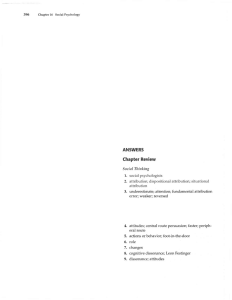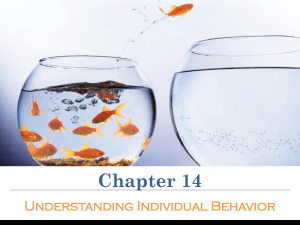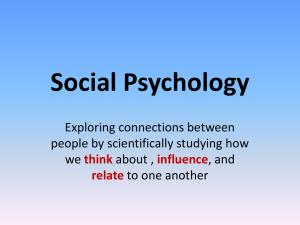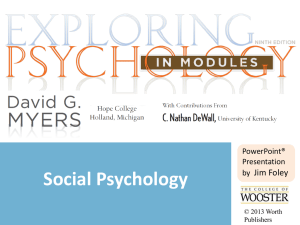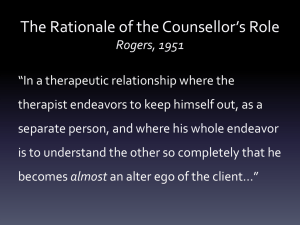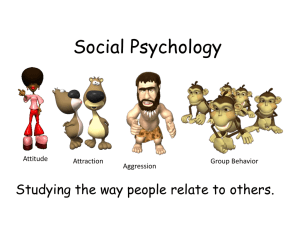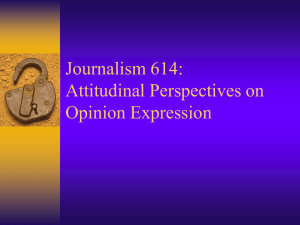a PowerPoint Presentation of Module 43
advertisement
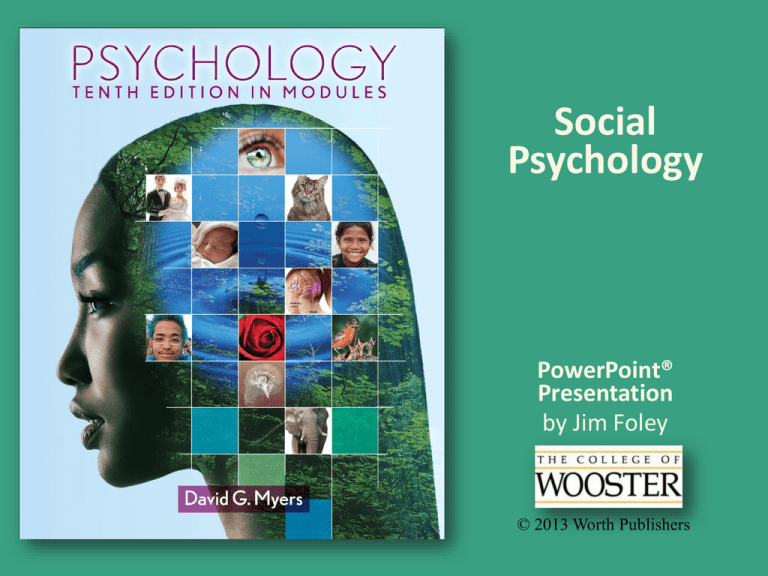
Social Psychology PowerPoint® Presentation by Jim Foley © 2013 Worth Publishers Module 44: Social Thinking Social Thinking Attribution: Identifying causes Attribution: a conclusion about the cause of an observed behavior/event. Attribution Theory: We explain others’ behavior with two types of attributions: Situational Attribution (factors outside the person doing the action, such as peer pressure), or Dispositional Attribution (the person’s stable, enduring traits, personality, ability, emotions) With all that we have learned about people so far in this course, you should make pretty good guesses about the nature of other people’s behavior, right? We, especially those raised in Western, Individualist cultures, tend to make Fundamental Attribution Error Social Thinking: Fundamental Attribution Error See if you can find the error in the following comment: “I noticed the new guy tripping and stumbling as he walked in. How clumsy can you be? Does he never watch where he’s going?” What’s the error? Hint: Next day… “Hey, they need to fix this rug! I tripped on it on the way in! Not everyone tripped? Well, not everyone had a test that day and their cell phone was buzzing.” The Fundamental Attribution Error: When we go too far in assuming that a person’s behavior is caused by their personality. We think a behavior demonstrates a trait. We tend to overemphasize __________ attribution and underemphasize __________ attribution. Social Thinking: Fundamental Attribution Error We make this error even when we are given the correct facts: Williams College study: A woman was paid and told to act friendly to some students, unfriendly to others. The students felt that her behavior was part of a her disposition, even when they were told that she was just obeying instructions. Social Thinking: Self vs. Other/Actors and Observers When we explain our OWN behavior, we partly reverse the fundamental attribution error: we tend to blame the situation for our failures (although we take personal credit for successes). This happens not just out of selfishness: it happens whenever we take the perspective of the actor in a situation, which is easiest to do for ourselves and people we know well. Social Thinking Emotional Effects of Attribution Problematic behavior: someone cuts in front of us. How we explain someone’s behavior affects how we react to it. Social Thinking: Attitudes and Actions Attitude: Feelings, ideas, and beliefs that affect how we approach and react to other people, objects, and events. Attitudes, by definition, affect our actions; We shall see later that our actions can also influence our attitudes. Early in the day, you see a fellow student in the cafeteria spill a whole tray of food as she trips over something on the floor. You think to yourself, “Wow, she sure is clumsy!” Later on in the day, you also trip in the cafeteria and spill your tray. Continued on next slide Continued from previous slide You think to yourself, “Wow, this floor is uneven and dangerous, someone should fix it!” This illustrates the psychological concept called: A. B. C. D. foot-in-the-door. bystander apathy. fundamental attribution error. out-group bias. Social Thinking: Persuasion Two cognitive pathways to affect attitudes Central Route Persuasion Going directly through the rational mind, influencing attitudes with evidence and logic. “My product has been proven more effective.” Peripheral Route Persuasion Changing attitudes by going around the rational mind and appealing to fears, desires, associations. “People who buy my product are happy, attractive!” Social Thinking Attitudes affect our actions when: 1. 2. 3. 4. “I 1. 2. 3. 4. External influences are minimal The attitude is stable The attitude is specific to the behavior The attitude is easily recalled. Example: feel like [attitude] eating at McD’s, and I will [action];” There are no nutritionists here telling me not to, I’ve enjoyed their food for quite a while, It’s so easy to get the food when I have a craving, It’s easy to remember how good it is when I drive by that big sign every day.” Social Thinking: Actions affect attitudes: If attitudes direct our actions, can it work the other way around? How can it happen that we can take an action which in turn shifts our attitude about that action? Through three social-cognitive mechanisms: The Foot in the Door Phenomenon The Effects of Playing a Role, and Cognitive Dissonance Social Thinking: Small Compliance Large Compliance A political campaigner asks if you would open the door just enough to pass a clipboard through. [Or a foot] You agree to this. Then you agree to sign a petition. Then you agree to make a small contribution. By check. What happened here? Social Thinking: Small Compliance Large Compliance The Foot-in-the-Door Phenomenon: the tendency to be more likely to agree to a large request after agreeing to a small one. Affect on attitudes: People adjust their attitudes along with their actions, liking the people they agreed to help, disliking the people they agreed to harm. Bart complied with his friends’ request to join them in smashing decorative pumpkins early one Halloween evening. Later that night he was surprised by his own failure to resist their pressures to throw eggs at passing police cars. Bart’s experience best illustrates the: A. B. C. D. bystander effect. foot-in-the-door phenomenon. fundamental attribution error. frustration-aggression principle. Professor Stewart wrote a very positive letter of recommendation for a student despite his having doubts about her competence. Which theory best explains why he subsequently began to develop more favorable attitudes about the student’s abilities? A. B. C. D. Cognitive dissonance theory Social exchange theory Two-factor theory Scapegoat theory Social Thinking: Role Playing Affects Attitudes “No man, for any considerable period, can wear one face to himself, and another to the multitude, without finally getting bewildered as to which may be the true [face].” -- Nathaniel Hawthorne “Fake it till you make it.” --Alcoholics Anonymous slogan When we play a role, even if we know it is just pretending, we eventually tend to adopt the attitudes that go with the role, and become the role. In arranged marriages, people often come to have a deep love for the person they marry. Actors say they “lose themselves” in roles. Participants in the Stanford Prison Study ended up adopting the attitudes of whatever roles they were randomly assigned to; “guards” had demeaning views of “prisoners,” “prisoners” had rebellious dislike of the “guards.” Cognitive Dissonance If Fiona agrees to do some fundraising for her college, her attitudes about school finances might shift to resolve her cognitive dissonance. 19
